As the sun rises over a misty marsh, the thrill of duck hunting beckons enthusiasts to embrace the wild.
With its unique blend of skill, strategy, and respect for nature, duck hunting is more than a pastime; it’s a cherished tradition for many.
However, to navigate this intricate landscape, hunters must equip themselves with an essential understanding of various aspects of the sport.
To maximize success in the field, one must first grasp the distinctions between diver and dabbling ducks, as well as the essential hunting methods such as decoying and calling techniques.
Moreover, the right gear—from waterfowl shotguns to warm clothing—plays a pivotal role in ensuring a safe and enjoyable experience.
Understanding regulations, safety protocols, and the seasonal behaviors of ducks further enhances a hunter’s ability to adapt and succeed in varying conditions.
This article serves as a comprehensive guide to duck hunting essentials, covering everything from identifying different duck types to preparing for a successful trip.
By delving into these crucial elements, both novice and seasoned hunters can enrich their experience and contribute to the legacy of hunting responsibly.
Understand the Different Types of Ducks
Duck hunting in North America is a pastime that embroils hunters in a diverse world of waterfowl species, each with distinctive characteristics and behaviors that challenge even the most skilled outdoorsmen.
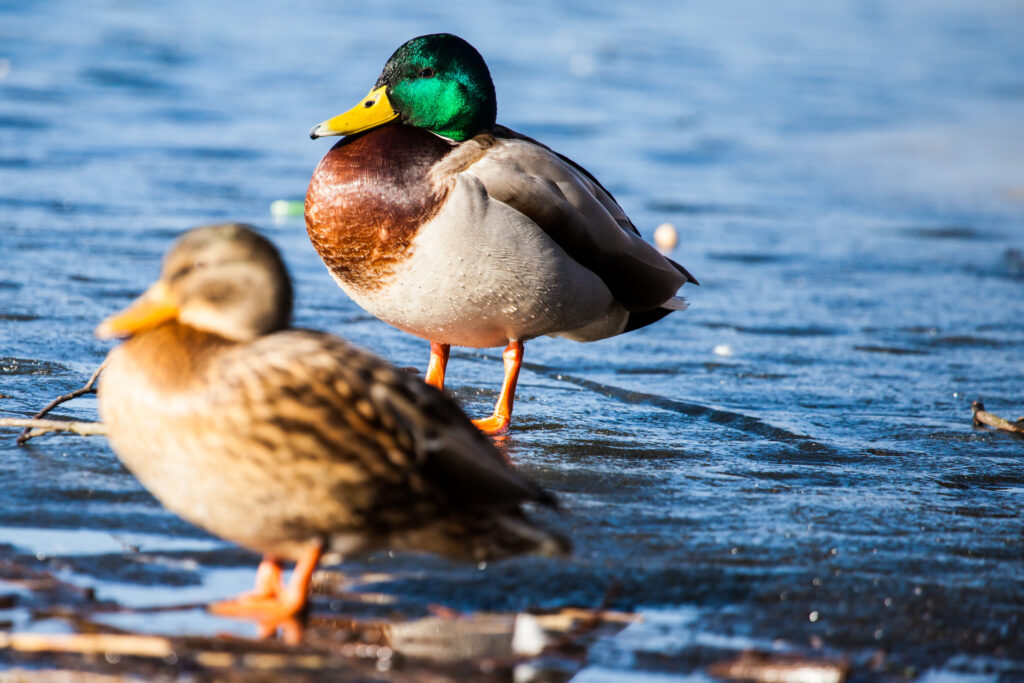
As the leaves change color and the northern landscapes cool, migratory game birds like ducks and geese begin their journey to warmer feeding areas, providing duck hunters with a window of opportunity that spans the autumn and winter months.
Among these birds, species such as the mallards, renowned for their iridescent green heads, the regal canvasbacks, swift northern pintails, and the vibrantly patterned wood ducks are pursued for their beauty and the sport.
The hunting of these birds goes beyond mere recreation—it’s a tradition that’s intricately linked with conservation narratives.
Revenue from Federal Duck Stamps, which are now available as Electronic Duck Stamps at license agents nationwide, is crucial in funding habitat conservation.
Hunters playing their part in this cycle help ensure the survival of waterfowl species across the continent, making duck hunting a conservation story as much as a sports story.
Waterfowl hunting is not just about the pursuit but also about understanding the ecology and habits of the winged quarry.
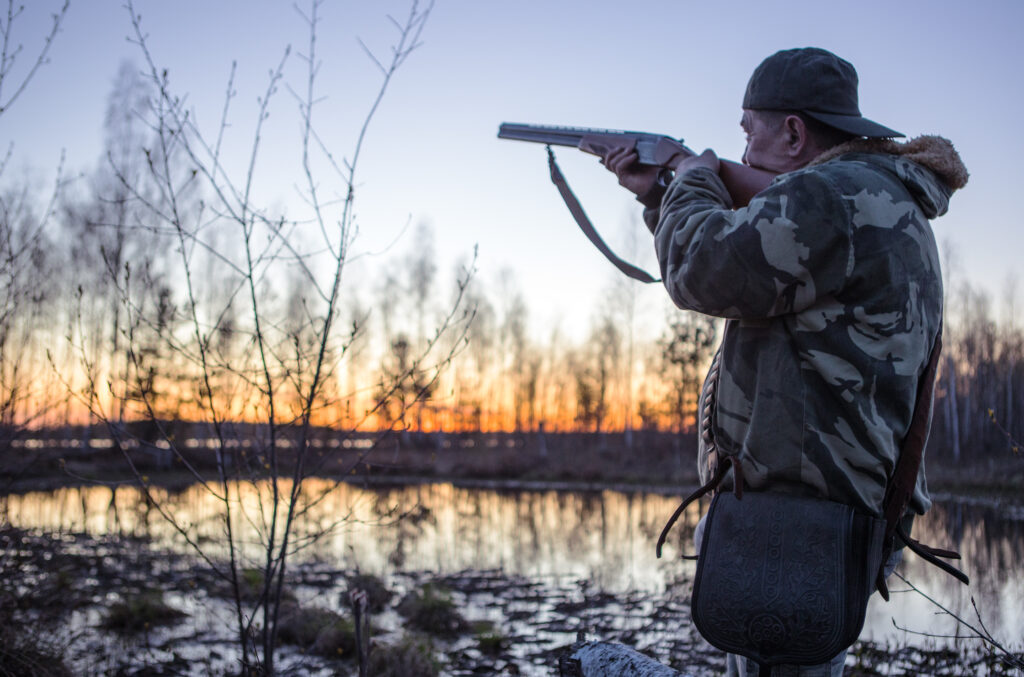
Sea ducks, for example, represent a unique subset that includes species like the long-tailed duck, eider, and scoter, often found in coastal areas.
Meanwhile, the skyward symphony of ducks and geese often overlap, as their shared habitats and synchronized migratory patterns put them on the same calendar, offering hunters seasons of plentiful action.
A deeper look reveals a comprehensive list of quarry:
- the redhead with its stunning crimson head
- the unassuming gadwall
- the diminutive yet swift-flying bufflehead
- and a variety of teal species, each adorning the marshes and skies with their individual splendor
As migratory waterfowl make their way across the continent, hunters prepare their gear and knowledge in anticipation of the hunting season.
Diver Ducks
Diver ducks are the long-distance travelers of the waterfowl world, taking to the skies later than their dabbling contemporaries and often logging impressive flying miles.
Their takeoffs are powerful, often requiring a runway of open water to get airborne, and their flights are purposeful laps around the lake or bay.
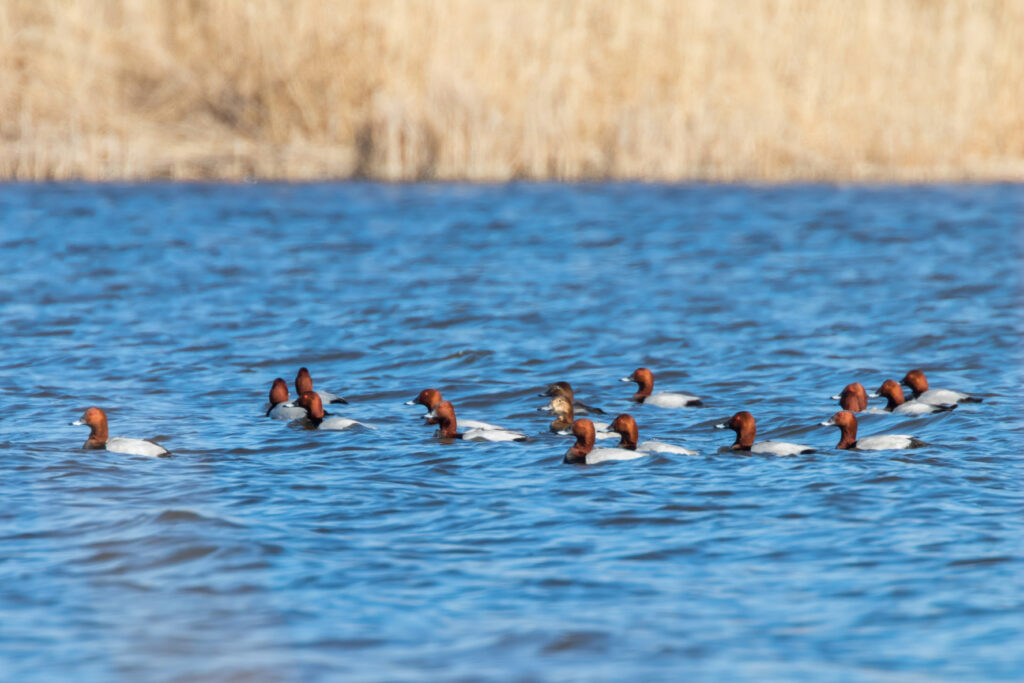
These ducks, such as the elegant canvasbacks and sturdy bluebills, are unfazed by choppy waters and possess the adaptability to thrive in a range of conditions.
When hunting these birds, decoy spreads can make the difference between a fruitful day and an uneventful outing.
Bluebill and redhead decoys are notably effective in enticing these tenacious divers. Yet, decoying these birds can be an exercise in patience.
Diver ducks might circle a decoy spread muliple times with maddening indecision, reminiscent of the caution exhbited by late-season mallards and the elusive black duck.
Nevertheless, witnessing a flock of canvasbacks—a flash of white and gray—commit to a spread remains one of duck hunting’s most exhilarating experiences.
Dabbling Ducks
Contrasting their diving counterparts, dabbling ducks, sometimes thought of as the aviary helicopters, are diurnal fliers, lifting off from the water’s surface in a vertical burst and decorating the day with their bustling activity.
These ducks—mallards, pintails, and teal—are often found tipping forward in the water, tail feathers pointed skyward, as they graze on shallow water sustenance.

Dabblers are more responsive and interactive with decoy spreads, often making them a favorite of duck hunters.
Their flight and decoying patterns, however, require hunters to study and anticipate their erratic behavior, especially as these species grow wary with increasing human pressure.
An effective decoying strategy for dabblers might include a dozen decoys or more, arranged in a way that simulates the natural movements and feeding patterns of these ducks.
Hunters must remain vigilant, for these birds can change their approach based on everything from the local pressure to the specific region of North America they’re in.
Whether foraging in the flooded rice fields or tipping in a sheltered marsh, these ducks present a dynamic challenge to hunters who must match wits with wildlife that has evolved to survive seasons of pursuit.
In the pursuit of ducks, whether on public land or private, whether from the concealed vantage of a duck boat or a shoreline blind, hunters are united by the challenges of waterfowl identification and the thrill of the waterfowl hunt.
For every species, the dance is different, and for every hunter, the story is unique.
Duck hunting is a blend of skill, strategy, and conservation—a tribute to the wild game that grace the skies of North America.
Essential Duck Hunting Methods
The pursuit of waterfowl such as ducks and geese is a time-honored tradition that combines skill, patience, and knowledge of the avian quarry.
The hunting season primarily spans autumn and winter, capitalizing on the migratory patterns of these birds as they travel to warmer climes for feeding post-breeding.
During this period, hunters employ a variety of tactics to outsmart their feathered targets.
One indispensable tool in the waterfowl hunter’s arsenal is the hunting blind. A blind serves the vital function of concealing the hunter from the sharp eyes of ducks and geese.
It can be as simple as natural cover or as complex as a constructed shelter, but its effectiveness lies in its ability to blend into the surroundings seamlessly.
Decoys are another key component of a successful hunt. However, managing these artificial lures on public waters comes with certain responsibilities.
Notably, decoys must not be left unattended during specific times, nor should they ever pose a danger to navigation. These regulations are in place to ensure safety and equitable use of shared resources.
Ethical hunting practices also demand that hunters must swiftly recover any migratory game birds that have been killed or injured.
It is a legal requirement for all birds to remain in the hunter’s custody while in the field. This not only respects the game but also upholds the sporting spirit of fair chase.
Duck hunting conditions require hunters to adapt to the elements, which can be unpredictable and harsh.
Effective layering of gear is paramount for comfort and safety.
Outfitting oneself with weather-appropriate clothing enables a hunter to stay focused and endure the long, often cold stakeouts that are synonymous with waterfowl hunting.
Decoying Techniques
For decoying techniques to be effective, reality is the watchword.
Decoys that closely resemble actual ducks in appearance will significantly increase the odds of a successful waterfowl hunt. The visual deception provided by a lifelike decoy can be the deciding factor in whether a flock decides to approach.
An optimally curated decoy set often mirrors the life-sized social structures of ducks.
A natural balance might consist of approximately one mallard drake to four hens. This ratio not only looks more realistic but also appeals to the natural instincts of the ducks.
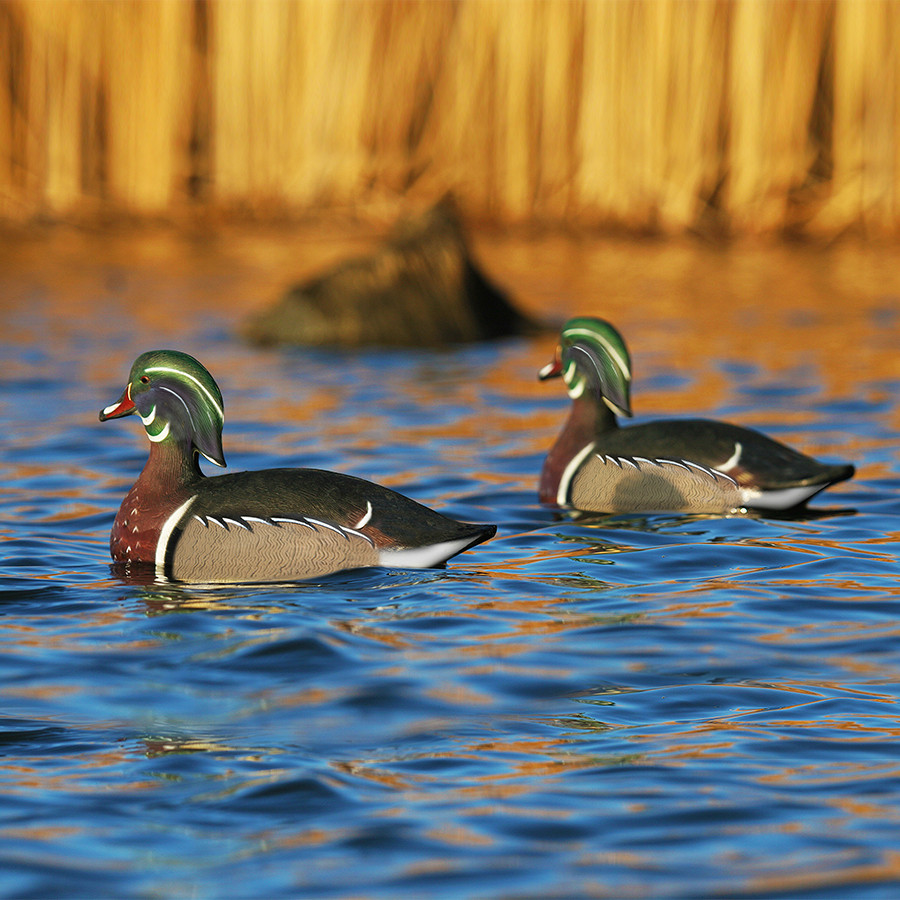
Motion has transformed the art of decoying. The advent of spinning wing decoys, for example, has radically altered the hunters’ ability to attract ducks by emulating the activity of a landing flock.
These dynamic additions to your decoy spread can prove irresistible to passing birds.
Further enhancing the effectiveness of decoys is their quantity and variety.
A combination of six to eighteen floating decoys alongside at least one motion decoy can create an alluring scene.
It’s vital to abide by the legal requirements, ensuring that these decoys are not placed on public lands or waters more than two hours before legal shooting hours.
Calling Techniques
Duck calling moves beyond sheer imitation and evolves into an art form, serving as a hunter’s linguistics to draw ducks closer.
Even though every hunter aspires to perfect their calls, there is a prevalent belief that less is more. Overcalling can disturb rather than attract ducks and should be avoided.
The selection of calls must be tailored to the target species.
Whereas mallard and goose calls are staples, they might not be necessary when hunting puddle ducks like wood ducks and teal.
It’s the intricate knowledge of the ducks’ behaviors and preferences that shapes successful calling.
Developing calling techniques involves practice and an understanding of timing. Hunters must discern the fine line between enthusiasm and overzealous calling.
It’s not uncommon for hunters to get carried away, with excitement potentially undermining their technical skill. Hence, a balanced, practiced approach to calling is recommended for enticing these wary birds effectively.
Success in duck calling is contingent upon knowing when and how to call. This entails recognizing the ducks’ patterns and vocalizations. Here’s a quick guide for essential duck calling principles:
- Understand duck behavior to determine the right calling technique.
- Use calls that are specific to the duck species present in the hunting area.
- Practice restraint – avoid overcalling to prevent scaring ducks away.
- Invest time in regular practice to refine your calling proficiency.
Like any other hunting art, becoming proficient at calling takes time and practice. Many enthusiastic hunters find their passion outpaces their skill, highlighting the importance of continued learning and patience in the pursuit of duck calling mastery.
Necessary Gear for Duck Hunting
When embarking on a duck hunting adventure, it’s crucial to equip yourself with the proper gear to increase your chances of a successful hunt.
Each piece of equipment serves a specific purpose and is designed to help you blend into diverse environments, lure in waterfowl effectively, and ensure a safe and rewarding hunting experience.
From reliable shotguns and camouflaged clothing to meticulously crafted decoys and transportation methods suited for the terrain, every item in your arsenal plays an integral role.
Regular maintenance of your gear is also key, particularly with firearms which need to be oiled regularly to remain functional, especially after exposure to harsh elements like saltwater.
Let’s delve into the specific necessities that every waterfowl hunter should consider before heading out into the wild.
Waterfowl Shotgun Options
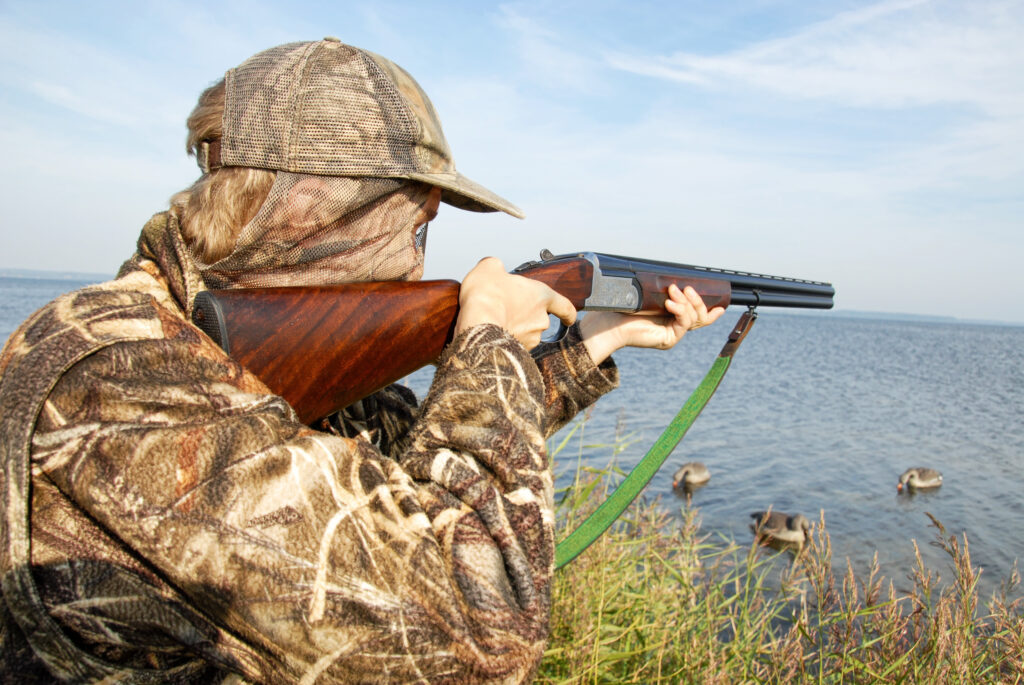
For duck hunters, a reliable shotgun is the cornerstone of their hunting equipment.
Pump-action shotguns stand out in the field due to their durability and the ease with which they can be maintained.
Particularly in wet and salty environments, hunters must remember to oil their shotguns regularly to prevent corrosive damage.
While there’s a range of shotguns available, expensive models aren’t a prerequisite for a successful hunt.
Beginners and seasoned hunters alike can depend on a sturdy pump-action shotgun, finding it serves well without breaking the bank.
Choosing the correct ammunition is also crucial, as waterfowl hunting requires shotguns capable of dispersing a wide pattern of round pellets to increase hit chances on these agile, airborne targets.
Warm and Camouflaged Clothing
The right attire for duck hunting goes beyond fashion; it’s about functionality and adaptation to harsh and changeable weather conditions.

The use of layers allows hunters to comfortably adjust to temperature shifts throughout the day.
Investing in high-quality base layers and outer garments is essential to trap warmth and block the elements.
Effective camouflage is just as important—it’s vital to match the patterns to the specific environment to avoid detection by waterfowl.
Waterproof and insulated outerwear not only helps disguise a hunter but also protects against the discomfort of cold and wet conditions, enabling hunters to remain vigilant and ready.
Effective Decoys
Decoys are a hunter’s silent partner, key in convincing ducks to land within range.
To maintain realism and enhance their allure, decoys must be in good condition without faded colors or damage.
For those new to duck hunting, an assortment of mallard drakes and hens serves as a solid starting point since they are widely recognized by a variety of duck species.
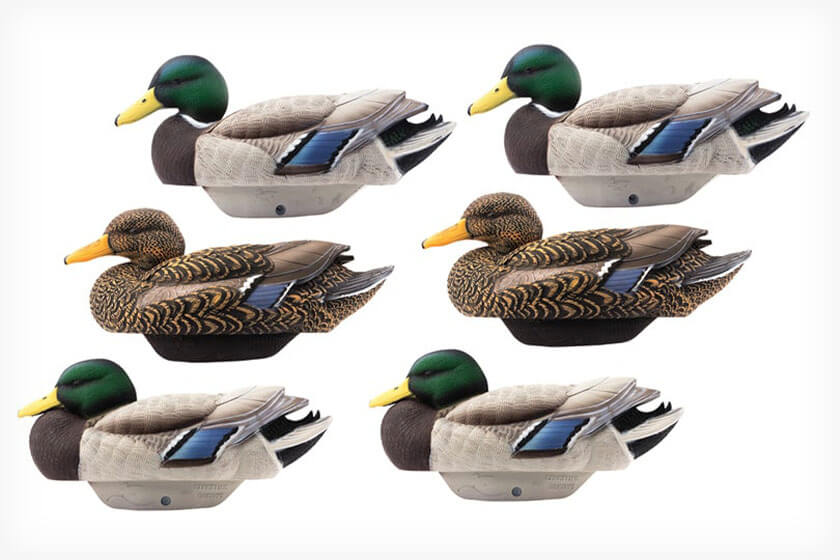
Crafting a strategic decoy spread is essential, especially under different hunting pressures, and can be complemented by adept calling techniques.
Stability is also essential during the hunt—you want to ensure you’re positioned well, whether that be from the shoreline or a boat, to maximize accuracy and harvest efficiency.
Transportation and Accessibility Gear
Access to prime hunting locations often requires specific modes of transportation.
Flat-bottomed boats or johnboats are favored for their stability in calm and shallow waters.
Alternatives like kayaks and canoes offer maneuverability through tighter waterways. But for hunting in larger water bodies where diving ducks dwell, more sizeable and stable boats are preferable to ensure safety and effectiveness.
These boats can double as sneakboxes, which are mobile hunting blinds, delivering both stealth and a vantage point for hunters lying in wait.
Implementing the right mix of accessibility gear ensures you reach the best spots well-equipped to focus on the hunt itself.
With consideration given to these essential pieces of gear, duck hunters can set themselves up for a rewarding experience, one where tradition, respect for nature, and the thrill of the hunt coalesce into unforgettable conservation stories.
Understanding Regulations and Safety
Duck hunting is a popular sport that comes with a responsibility to abide by regulations designed to conserve migratory game bird populations and ensure hunter safety.
Before setting out, it’s paramount for duck hunters to be cognizant of the rules and guidelines that govern this activity.
Not only are these measures in place to protect the birds and their ecosystems, but they also uphold ethical hunting practices.
Local Hunting Regulations
Duck hunting regulations can vary significantly by region within North America.
Adherence to local laws is essential for hunters who frequent public lands, private land, or specific hunting environments such as rice fields or shallow water areas.
Typically, these local rules are in concordance with federal regulations but may have additional restrictions, especially at National Wildlife Refuges.
It’s incumbent upon hunters to review the official federal regulations documented in Title 50, Code of Federal Regulations, Part 20 – Migratory Bird Hunting, as these outline the base guidelines for the sport.
Certain actions are strictly prohibited under these laws.
For example, hunting using live decoys, engaging migratory game birds from a moving vehicle, or the use of a shotgun larger than one capable of holding more than three shotshells without a plug is deemed illegal.
Due to regional variances, it’s highly advised to connect with local enforcement authorities or license agents to secure the most accurate and up-to-date guidance.
Federal Guidelines and Licensure
On a federal level, all hunters planning to pursue doves, ducks, or any other migratory birds must adhere to specific guidelines that include completing the Harvest Information Program (HIP) survey.
This free registration process is a crucial step in becoming compliant with legal hunting standards and aids in the conservation of migratory waterfowl.
Moreover, hunters 16 years of age and older are mandated to obtain and carry a Federal Duck Stamp while hunting.
This stamp contributes to conservation stories, as proceeds from its sale help fund the U.S. Fish and Wildlife Service’s conservation efforts.
For youthful enthusiasts under 16, requirements are somewhat relaxed.
They must possess a youth hunting license but are exempt from requiring a Federal Duck Stamp or the equivalent state migratory bird permit.
This stamp must be validated with the hunter’s signature in ink across its face and is a necessary document to have while actively hunting.
Electronic duck stamps have been introduced as a modern alternative, providing immediate validation and are available for purchase from various state license vendors.
These e-stamps are valid for a 45-day period beginning from the date of purchase, after which a physical stamp must be acquired to continue lawful hunting.
Comprehensive understanding of these local and federal guidelines is not only critical to legal compliance but promotes a culture of safety and conservation within the duck hunting community.
Hunters are encouraged to invest time in waterfowl species and waterfowl identification education, ensuring they respect the limits of ducks per season and support sustainable hunting practices.
The combined efforts of waterfowl hunters are vital to the continued enjoyment and preservation of this revered pastime.
Hunting Conditions and Seasonal Variations
Duck hunting conditions across North America are often dictated by the cyclical patterns of the weather.
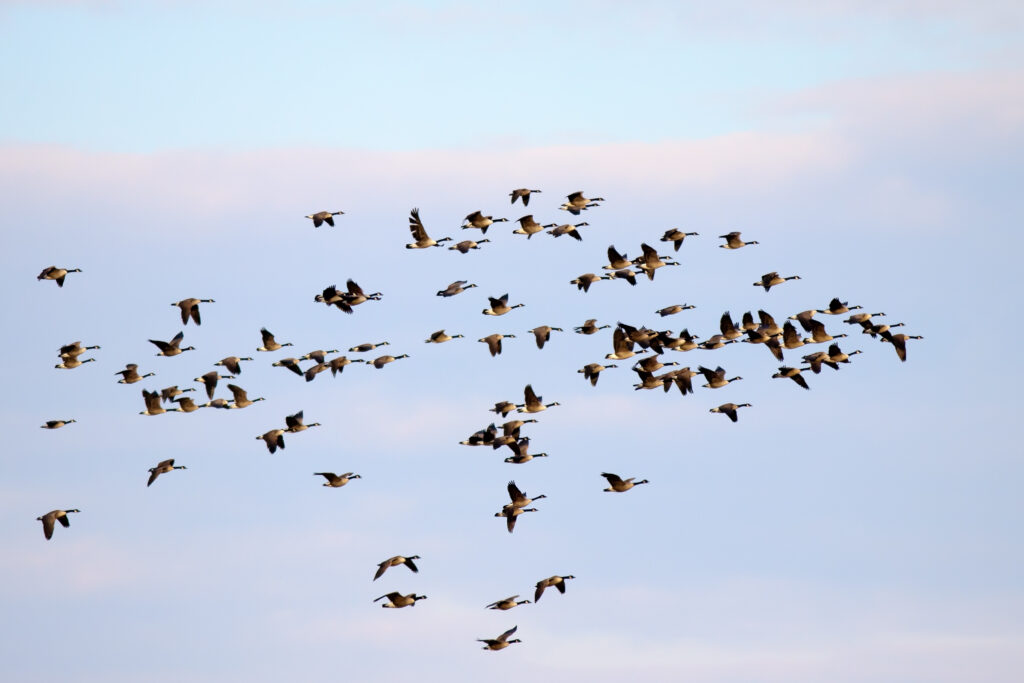
As autumn embarks and transitions into winter, hunters start preparing for the waterfowl hunting season—a period marked by the chilly climate that beckons migratory game birds to traverse to warmer zones.
This migration follows the breeding season, during which ducks raise their young before setting off on their journey.
Specific hunting regulations, including the timing of seasons and the determination of the daily limit of ducks, are uniquely structured by each state.
These regulations are formulated within the strategic frameworks prescribed by the U.S. Fish and Wildlife Service and further refined by Flyway Councils.
Each council is mindful of ecological conditions and conservation imperatives, ensuring waterfowl hunters partake in a sustainable harvest.
Weather conditions play a pivotal role in the day’s yield, as ducks are more prone to fly and forage in less-than-picturesque days.
When the skies are draped with gray and the winds unforgiving, ducks are on the move, presenting prime hunting opportunities.
Preparing for this involves more than just skill—it requires wearing appropriate gear.
Camouflage clothing and reliable waders are essential to blend into the natural landscape, providing hunters with both warmth and stealth.
By considering the capricious nature of waterfowl movement and weather, hunters maximize their chances of a successful harvest.
Weather Impact on Duck Behavior
Wind serves as an architect of duck hunting success, as still days usually translate to challenging hunting.
Minimal wind can render ducks less likely to move, decreasing chances for successful hunting. However, with a gentle gust, ducks take to the air, and opportunities for targeting them improve markedly.
Overcast and cloudy days may benefit the ducks, as such conditions reduce landscape contrast, making hunters more conspicuous.
Conversely, bright and sunny conditions offer hunters an advantage as they can better conceal themselves.
Cold weather instigates an uptick in duck activity—frigid temperatures encourage waterfowl to fly in search of food and shelter.
Thus, hunters often hope for chillier climates as ducks become more predictable and hunting success rates can surge.
Furthermore, when skies are cloud-filled, ducks have limited visual acuity, which can impede their movement.
Adapting decoy placements and hunting strategies becomes imperative under such conditions to evade the vigilant eyes of migratory waterfowl.
Seasonal Migration Patterns
The grand migratory pageant of waterfowl in North America is orchestrated along four primary flyways: the Atlantic, Mississippi, Central, and Pacific Flyways.
These aerial corridors chart the annual journeys of diverse species and are cornerstones of unique habitats.
The U.S. Fish and Wildlife Service not only established these flyways to streamline management but also to encourage international cooperation in conservation and regulation efforts.
Waterfowl hunters are often found in geographically strategic areas along the Mississippi Flyway.
These environments, such as marshes, rivers, and rice fields, are stopover points for ducks and geese, allowing hunters to converge in areas with high bird traffic.
Through close collaboration, the states and federal service jointly manage these waterfowl populations, setting adaptive season dates and bag limits to manage the wild game sustainably.
Organizations like Ducks Unlimited harness a landscape-specific conservation ethos, targeting efforts where the impact will most benefit waterfowl.
By guiding projects with refined scientific insights into wetland integrity and bird migration dynamics, conservationists strive to ensure the viability of habitats along these crucial migration paths.
Resources for Duck Hunters
Duck hunters utilizing the Atlantic Flyway, a critical migratory route for waterfowl, rely heavily on well-preserved marsh and wetland habitats.
These vital ecosystems, stretching from northern Quebec to Florida, are under threat from agricultural expansion and environmental pressures, making conservation a key component of responsible waterfowl hunting.
Key resources for duck hunters include:
- Proper Equipment: A reliable shotgun, preferably a durable pump-action model, is fundamental to duck hunting. Hunters must keep their firearms well-maintained to avoid rust, especially in corrosive saltwater areas.
- Ammunition: Non-toxic shot is mandatory; while steel is more affordable, higher performance can be obtained with bismuth or tungsten loads.
- Clothing and Gear: Comfort and invisibility are essential. Hunters should be outfitted in warm, camouflaged attire, and equipped with a range of decoys. Additionally, having a means of transportation, like a duck boat, can greatly assist in navigating to prime hunting spots on both public and private land.
- Licensing: It’s important to secure proper licensing, such as the Federal Duck Stamp, which is mandatory for hunting migratory game birds. For convenience, electronic duck stamps are available through license agents or online platforms.
For hunters scouting locations on public land, there are regulations to be mindful of when considering the limit of ducks allowed to ensure sustainable waterfowl populations. These regulations generally follow a state-by-state guideline.
Educational Programs for New Hunters
Ensuring a safe and ethical future for duck hunting starts with education.
All hunters born on or after January 1, 1975, need a hunter education course completion card to hunt in many states, highlighting the emphasis on safety in the sport.
For those eager to start immediately, a temporary hunter education exemption permit is available and valid for one year in some regions.
Many states offer hunter safety courses that are prerequisites for obtaining a license. Through programs such as the Decoy Adoption Program in Arkansas, new hunters receive not only equipment but also invaluable mentorship.
Organizations such as Ducks Unlimited provide another layer of educational support. They encourage hunters to:
- Become members
- Volunteer for conservation projects
- Engage in activities to deepen their understanding of waterfowl species, conservation stories, and the importance of wetland habitats
This involvement simultaneously educates hunters and contributes to broader conservation efforts.
Community Hunting Events
Community events play a pivotal role in fostering a culture of responsible waterfowl hunting.
Events such as mentored youth hunts provide invaluable hands-on experiences and knowledge-sharing.
Ducks Unlimited is one organization that facilitates community involvement, volunteering opportunities, and waterfowl conservation initiatives that contribute to sustaining essential wetland habitats.
Arkansas, known for its vibrant duck hunting season, sees an influx of over 100,000 waterfowl hunters annually, creating a robust community where seasoned hunters can share knowledge and experiences with novices.
Programs like the Decoy Adoption Program encourage this sharing spirit by providing educational resources and enabling new hunters to benefit from the experience of others.
It is crucial for hunters participating in community hunting events to be aware of local regulations, which can differ significantly, especially in areas where certain lands might be designated as waterfowl sanctuaries with hunting restrictions.
This level of engagement not only enhances the individual hunter’s experience but also supports the collective effort to maintain healthy waterfowl populations for seasons to come.
Here’s a quick reference to community involvement in duck hunting:
| Event Type | Description | Impact |
|---|---|---|
| Mentored Hunts | Supervised hunting experiences for beginners | Education & Skill Building |
| Volunteer Opportunities | Participation in conservation efforts | Habitat Preservation |
| Decoy Adoption Program | Donation and re-use of old decoys | Resource Sharing & Community Support |
| Local Regulations | Varying rules on public and private lands | Legal Compliance & Sanctuary Respect |
Community hunting events are not just about the thrill of the hunt; they’re about forming connections, respecting wildlife and contributing to the conservation stories that ensure the future of these traditions.
Preparing for Your Duck Hunting Trip
Embarking on a duck hunting trip requires thorough preparation to ensure a safe, enjoyable, and successful experience.
The bare essentials include a reliable shotgun with appropriate ammunition, warm and comfortable camouflaged clothing suitable for the elements, an array of decoys to lure in your prey, and dependable transportation to navigate the hunting grounds.
Scouting Locations
Scouting Locations for Duck Hunting
Successful duck hunting often hinges on effective scouting.
Identifying where ducks are, particularly in regions dotted with water bodies, is vital.
For example, in the upper Midwest where public land flourishes, Minnesota alone boasts over 14,000 lakes, which beckon duck hunters to explore.
Mastery over the local topography and pinpointing prospective hunting spots play a significant role in a hunter’s success.
Amidst the vast landscape, many waterfowl hunters turn to public lands, employing diligent scouting to track down flocks, especially when access to private property is not an option.
This practice is not a set-and-forget skill but rather a dynamic one.
As ducks migrate and habitats evolve with the seasons, hunters must adjust their scouting tactics accordingly to anticipate the presence of ducks.
Given the importance of scouting in duck hunting, here are key places and habitats to consider:
- Ponds
- Streams
- Rivers
- Marshes
- Rice Fields
- Shallow Waters
Adapting to the seasonal shifts and understanding migratory patterns is the key to a rewarding hunt. Whether on the vast public lands or the fewer private ones, the prepared hunter will always have the upper hand.
Packing Essentials
To ensure a successful and comfortable duck hunting experience, prioritizing your gear is essential. Here’s a rundown of the crucial items you’ll need:
- Waterfowl Shotgun: Quality matters. A reliable pump-action shotgun is a popular choice due to its durability and ease of use. Make sure to maintain it with regular oiling after each hunt, especially when exposed to saltwater.
- Appropriate Clothing: Warmth, comfort, and camouflage are non-negotiable. Your clothing should enable you to blend into the environment seamlessly while protecting you from the elements. Always choose high-quality garments.
- Layered Outfitting: Conditions can change rapidly out in the field. Layer your clothing to easily adjust to varying temperatures throughout your hunt.
- Durable Waders: Don’t compromise on waders. High-quality waders keep you dry and comfortable in shallow waters. Cheap alternatives may ultimately hamper your hunting experience.
- Decoys and Gear: While a spread of a dozen decoys can enhance your hunt, prioritize the essentials—clothing and waders—are what will keep you functional and focused on the wild game.
Remember, the right gear elevates your waterfowl hunting adventure. Choose wisely and always check your equipment before heading out to public or private land.
Read also : Coyote hunting guide or Turkey hunting tips

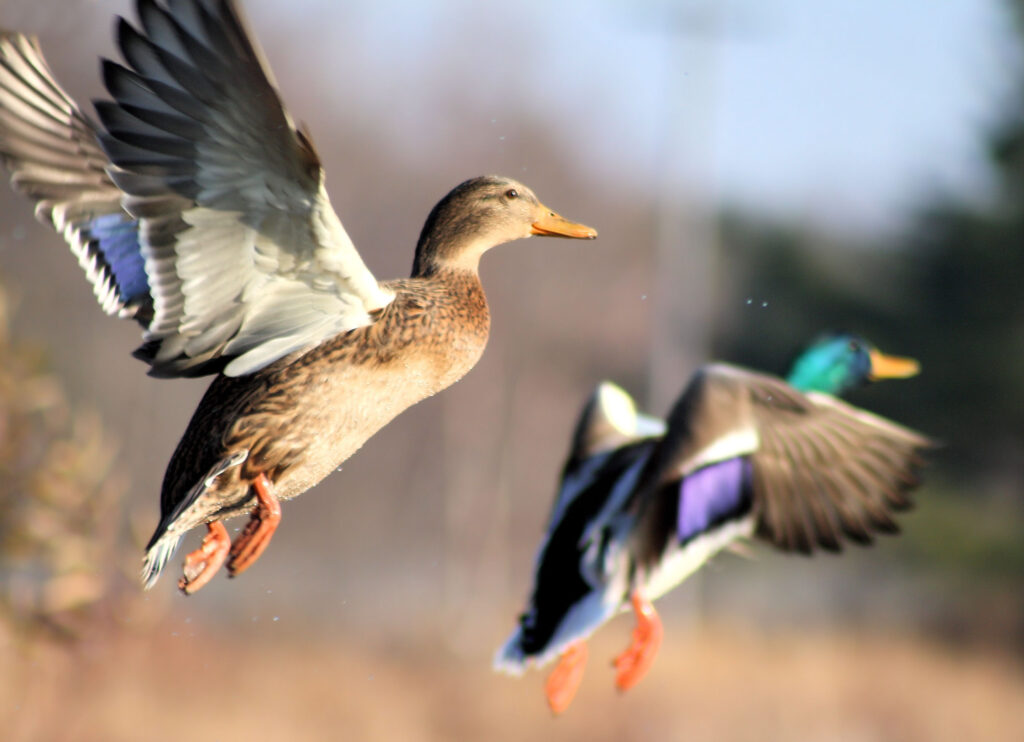
4 thoughts on “Duck Hunting Essentials: What Every Hunter Should Know”